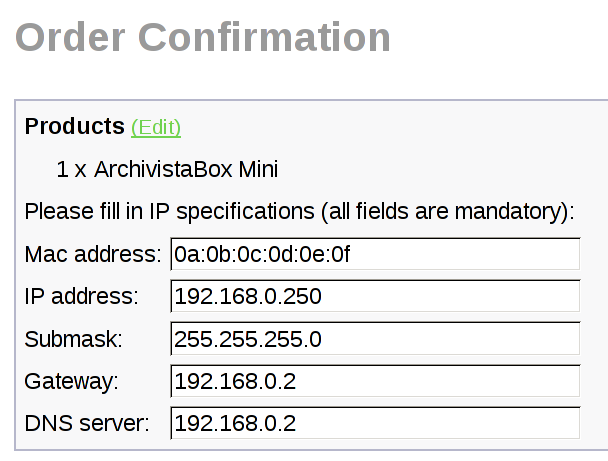Smallest virtualisation platform worldwide
Egg, 14th February 2014: The new ArchivistaBox Mini 2014 is introduced in this blog entry. Thanks to yet another reduction in size of approx. 20%, the world’s smallest virtualisation platform is now available as a free download. Why an ISO-size of less than 60 MB makes so much sense, how easy it is to set up the ArchivistaBox, what the RAM-mode is all about and how a cluster can be created… all this and a bit more can be discovered in this blog entry.

World record: 60 MB for a complete virtualisation infrastructure
The first version of the ArchivistaBox for virtualisation was released by us in 2009. If initially the first solution was an updated Proxmox-Fork, today’s ArchivistaBox Mini can no longer be compared with Proxmox. The focus is very different. Whilst Proxmox mutated to an all-encompassing data centre (with a current size of 480 MB), ArchivistaBox Mini is designed to make virtualisation a simple(r) technology. Not only has the ISO file been reduced considerably to under 60 MB (which makes for extremely rapid starting), but the ArchivistaBox Mini also comes with completely automatic configuration – even when linking servers (clusters).
Under these conditions, the ArchivistaBox Mini performs “class compliant”. It is based on Debian. And those who want to can install additional packages at any time using ‘apt-get update’ and ‘apt-get install xyz’. One thing is worth noting: the ArchivistaBox (with the exception of virtualised guests) runs exclusively in the main memory (RAM). Those expecting an installation with user interaction will be just as disappointed as those expecting (as with all other solutions) to have to reboot following installation. Once the ISO / stick has been booted, that’s it! When starting, the server is automatically configured, so that after approx. 20 or 30 seconds (1 – 2 minutes in the case of a cluster), the infrastructure is ready to use.
Of course, the “world record” label brings with it high expectations. The truth is, there is no other platform anywhere which offers a complete virtualisation suite for just 60 MB, nor one which is based on standard Debian. That is neither available with the leading KVM Open Source Technology, nor with XEN, and the fact that the top dog needs a full 650 MB and Windows into the bargain is a generally accepted technical requirement. All the above platforms need a lot of time and memory in order to bring them on line, not to mention maintenance. The ArchivistaBox Mini 2014 is the first platform that is able to get along without updates – swap the ISO file (and reboot) and that’s it (up- and downgrading possible). So the ArchivistaBox Mini 10 Gbit is already dominant with its standard configuration (no redundant switches are required). In a nutshell, it allows a server to be driven with less than 512 MB RAM (the current record is 410 MB). A web browser is all that’s needed – no additional plug-ins (such as Java) are required.
The simplest installation is the one that doesn’t take place.
Just over two years ago, freiesMagazin.de published a detailed article on ArchivistaBox (also accessible at Prolinux.de and on our website). All these steps have in the meantime become obsolete – even if the underlying technology is the same. The article described the automated booting facility, for which the syslinux.cfg and isolinux.cfg files (in the root directory of the ISO file) are responsible. And so to an example:
DEFAULT ram
TIMEOUT 10
PROMPT 1
DISPLAY boot.msg
label ram
kernel vmlinuz
APPEND initrd=initrd.img quiet pci=nocrs mac.0a:0b:0c:0d:0e:0f.eth0.192.168.0.250
submask.255.255.255.0 gw.192.168.0.2 dns.192.168.0.2 lang.de
This data automatically boots and configures the server. Now, we know that swapping the ISO files is not always a straightforward matter for administrators. So, last year we set up a free service in our Web Shop that allows the necessary CDs to be created. In order to generate these, go into the Web Shop and select the product “ArchivistaBox Mini”. Then follow the ordering process through to the end (when the next order form is shown).

The desired IP addresses can be entered at this point. For Mac addresses, the network card equipment number is required and this must match with the address of the computer on which the CD is to be booted. Of course, one may ask why all this fuss and exactness is necessary. Well, nowadays many computers have umpteen network cards, but ArchivistaBox Mini must use the correct (desired) network card on each and every occasion.
Tip 1: If the hardware address is not known – set up ArchivistaBox Mini using default values, then boot. Now press the ENTER key and then register with ‘root’ and ‘archivista’. Type in ‘ifconfig eth0′ for the root shell and you should then see the hardware address of the card (e.g.: HWaddr 86:b6:9e:97:bc:22). For Mac addresses, the last six pairs of digits must then be entered into the above form.
Tip 2: In order to set up an ISO file with English masks, the English language must first be activated in the Shop.
Comment: We received a lot of emails last year asking why the “private use” restriction applies in respect of licensing. Our response is that no right-minded administrator in the server domain would ever set up a virtualisation infrastructure without either a) fully understanding servers, or b) obtaining a support subscription. It would also make no sense whatsoever to allow a 0-8-15 service provider to remove our logo and sell the ArchivistaBox Mini as if it were his own. We were subjected to this last year and therefore believe that the private use ruling makes sense. To put it in a nutshell: Private use safeguards us and protects you.
 Making cluster set up easy
Making cluster set up easy
The concept of using ArchivistaBox servers for virtualisation has already been the subject of numerous detailed talks and lectures. More radically, the notion that a simple concept actually needs no discourse has begun to take root over the recent past. In essence, the solution should be so simple that no additional information whatsoever is required. Conseq uently, our scripts concentrate on how DRBD clusters operate and how they can be set up. So what is at issue? The virtualised guests are saved in the hard drive. In addition to data backup (just in case), the hard drives are normally operated in pairs, i.e. data is saved onto two hard drives simultaneously.
However, should a computer fail, either the drives would have to be removed or the machine would have to be repaired (providing that were possible). Hot-swap drives can, of course, be replaced whilst the system is in operation, but that means having a replacement on site. With ArchivistaBox Mini operating in cluster mode, two equitable computers – each with two hard drives – are at all times available. The first computer simultaneously saves data to the second computer (and vice versa) so that the relevant data is always available on two independent computers. This means that in the event of one of the computers crashing, the data can still be accessed on the second computer. It all sounds terribly complex, but in fact that is not the case.
In order to set up a cluster using ArchivistaBox Mini, simply go into the Web Shop and select the “ArchivistaBox Mini” twice. As soon as the IP address form is complete, there will already be two versions of the Mac and IP addresses. Logically, the network card identification of the second computer needs to be entered as the second Mac address and the second computer also needs to be given a different IP address. The ISO file is now set up for cluster mode operation. Once the download is complete, the ISO file (or stick) must be booted simultaneously onto both computers. The end result is a fully-configured ArchivistaBox cluster. It should be noted, however, that all four hard drives must have the same capacity. And in order to allow the ArchivistaBox to be set up, it is also important that the hard drives are completely erased (under Linux with (for example) dd if=/dev/zero of=/dev/sda bs=16M count=10 [deletion takes place with no prior warning]).
Comparison of the ArchivistaBox Mini and the ArchivistaVM
The ArchivistaBox Mini constitutes a fully-fledged virtualisation infrastructure up to and including the simple double cluster level. All other options are covered by the ArchivistaVM or SwissRocket; the important differences are set out below:
| ArchivistaBox Mini | ArchivistaVM / SwissRocket |
| Free-of-charge, maximum cluster: 2 | With / without hardware, maximum cluster: 7 |
| Hard disk mirroring with DRBD | Mirroring with RAID and/or DRBD |
| Number of hard drives per computer: 1-2 | Number of hard drives per computer: 1-24 |
| Number of network cards per computer: 1 | Number of network cards per computer: 6 |
| Debian-based, no X-Server | Additional X-Server (stand-alone operation) |
| Data backup with stop/cluster mode | Additional Restore-On-the-Fly |
| Settings saved to CD/stick | Setting saved to CD/stick and hard drive |
| System booted from CD/stick | System booted from CD/stick/hard drive/network |
| Restricted access to guests: no | Restricted access to guests (multiple users) |
| No support (community) | Support with guaranteed response times |
ArchivistaBox clusters (and SwissRocket, provided this is sold as a rack) can be scaled to almost any size (up to several hundred CPUs). This is better demonstrated in a practical example. A triple cluster with 3×24 CPUs, with 3×12 hard drives each offering 750 GB (i.e. 27 TB with triple redundancy, upgradeable to 3×24 or 54 TB), with 3×128 GB RAM and six redundant 10 Gbit network cards is obtainable for less than 20,000 Swiss francs (one of our customers already has this option up and running). Maintenance costs amount to a very reasonable 20% per annum (including free replacement in the event of any hardware defects).
Availability in the EU: Since, in the recent past, our experiences with both the Swiss and the German postal services have not been good, and we also do not advocate parcel services for the safe transportation of servers, we have decided, effective 2014, to only deliver this type of equipment within Switzerland. Customers located in the EU are more than welcome to receive packages from local suppliers, i.e. support will be given for the choice of hardware and the installation of components on site, based on ArchivistaVM Light.
Whether it’s ArchivistaBox Mini (which can be used free-of-charge), ArchivistaVM or even SwissRocket, all our products are based on the same software. Upgrading the ArchivistaBox Mini to a version that is subject to a fee can be done at any time, but there is no obligation to take advantage of an upgrade. Once the CD has been downloaded, no further registration is required. Updates can be obtained free of charge for each new release simply by going to our Web Shop.
P.S.: Note the new instruction for Windows with regard to allowing a bootable USB stick to be created directly from the ISO file.

